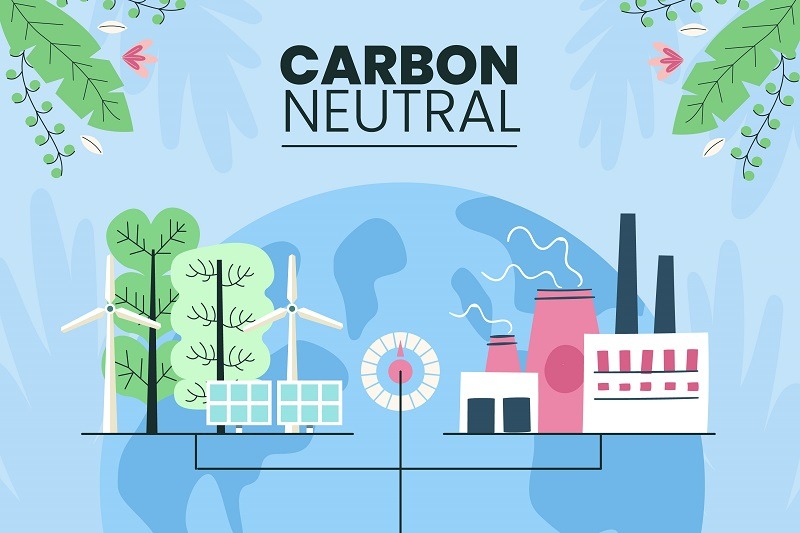As the world continues to grapple with the consequences of climate change, more and more companies and individuals are seeking ways to reduce their carbon footprint and make a positive impact on the environment. Three common terms used in this context are carbon-neutral, net-zero, and climate positive. In this blog, we will explore what these terms mean and how they can help address the challenge of climate change.
Carbon-Neutral
Carbon-neutral refers to a state where an individual, organization, or event has balanced their carbon emissions with an equivalent amount of carbon removal or offsetting. Carbon emissions are released when we burn fossil fuels such as coal, oil, and gas, as well as through various industrial and agricultural processes. Carbon removal, on the other hand, involves taking carbon out of the atmosphere through measures such as planting trees, restoring wetlands, or capturing carbon emissions from power plants and other sources.
Achieving carbon neutrality involves two steps. First, the individual or organization must quantify their carbon footprint, which is the total amount of carbon dioxide and other greenhouse gases emitted as a result of their activities. This can be done using various tools and methodologies, such as the Greenhouse Gas Protocol. Second, the individual or organization must take steps to reduce their carbon emissions as much as possible, through measures such as energy efficiency, renewable energy, and sustainable practices. Any remaining emissions can then be offset through carbon removal projects.

Net-Zero
Net-zero refers to a state where an individual, organization, or event has reduced their carbon emissions as much as possible and then balanced the remaining emissions with an equivalent amount of carbon removal or offsetting. The key difference between carbon-neutral and net-zero is that net-zero involves reducing emissions as much as possible before offsetting, whereas carbon-neutral focuses solely on balancing emissions and removals.
Achieving net-zero requires a more aggressive approach to reducing emissions than carbon-neutral. This may involve implementing more ambitious energy efficiency measures, transitioning to renewable energy sources, and making changes to supply chains and transportation practices. In addition, net-zero often requires the use of more advanced carbon removal technologies, such as direct air capture or carbon mineralization.
Climate Positive
Climate positive takes the concept of net-zero a step further by not only reducing emissions but actively removing more carbon from the atmosphere than is emitted. This means that an individual, organization, or event has a net-negative carbon footprint and is actively contributing to reversing the effects of climate change.
Achieving climate positivity requires a combination of aggressive emissions reductions and significant investments in carbon removal and sequestration technologies. This may involve a range of measures, from reforestation and regenerative agriculture to carbon capture and storage and carbon mineralization.
Why are These Terms Important?
Carbon-neutral, net-zero energy, and climate positive are important concepts because they represent concrete steps that individuals and organizations can take to reduce their impact on the environment and address the challenge of climate change. By setting ambitious goals for emissions reduction and carbon removal, we can begin to shift the trajectory of global greenhouse gas emissions and work towards a more sustainable future.
In addition, these concepts can help drive innovation and investment in new technologies and practices that can accelerate the transition to a low-carbon economy. By creating demand for carbon removal and sequestration technologies, for example, we can help bring down the cost and increase the scalability of these solutions, making them more accessible to a wider range of individuals and organizations.
Finally, these concepts can help raise awareness and inspire action on climate change by providing concrete goals and metrics that individuals and organizations can use to measure their impact and track their progress. By setting a target to become carbon-neutral, net-zero, or climate positive, we can create a sense of urgency and momentum around the need to address climate change and inspire others to join the effort.

Conclusion
Carbon-neutral, net-zero, and climate positive are all important concepts in the fight against climate change. While they differ in their level of ambition and approach, they all share the goal of reducing greenhouse gas emissions and mitigating the effects of climate change.
Achieving carbon-neutrality, net-zero, or climate positivity requires a combination of aggressive emissions reduction and investment in carbon removal and sequestration technologies. While it may be challenging to achieve these goals, the benefits of doing so are immense, including reduced environmental impact, increased resilience to climate change, and the creation of new opportunities for innovation and investment.
Individuals and organizations of all sizes can play a role in advancing these concepts. By setting ambitious targets for emissions reduction and carbon removal, investing in renewable energy and sustainable practices, and supporting policies and initiatives that promote climate action, we can all contribute to a more sustainable future.






